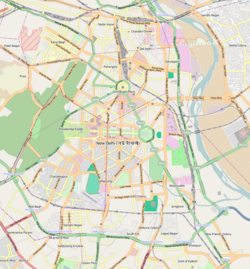Mubarak Begum Mosque
| Mubarak Begum Mosque | |
|---|---|
 The mosque in 2024 | |
| Religion | |
| Affiliation | Islam |
| Ecclesiastical or organizational status | Mosque |
| Ownership | Delhi Wakf Board |
| Status | Active |
| Location | |
| Location | Hauz Qazi, Old Delhi, Delhi NCT |
| Country | India |
Location of the mosque in Central Delhi | |
| Geographic coordinates | 28°39′00″N 77°13′34″E / 28.650°N 77.226°E |
| Architecture | |
| Type | Mosque architecture |
| Style | |
| Founder | Sir David Ochterlony |
| Completed | 1823 |
| Specifications | |
| Dome(s) | Three |
| Materials | Red sandstone; lakhori bricks |
The Mubarak Begum Mosque, also known as Randi ki Masjid (lit. 'Prostitute's Mosque'), is a 19th-century red sandstone mosque, located in Hauz Qazi, Old Delhi, Delhi, India. The Mughal-style mosque is also referred to as courtesan's (tawaif's) mosque, and is located near the Chawri Bazaar metro station.
On 19 July 2020, at approximately 6:45 am,[1] part of the mosque's central dome collapsed due to heavy rainfall.[2][3] The mosque is under the custody of Delhi Wakf Board. Closed for a period of time, as of 2024[update], the mosque was open for worship.
History
[edit]The mosque was built in the early decades of the 19th century in 1823 by a nautch dancer called Mubarak Begum who also served as a tawaif in the Mughal court.[4] The mosque was built during the Mughal era.
Mubarak Begum was born into a poor Brahmin family initially pursued her career as a dancing girl in Pune.[5]
When East India Company was established in India, Britishers made it compulsory for army men to either come along with their wives, or marry native women temporarily. "No Indian families would've agreed, so these ladies were their only recourse." Delhi's first British resident, Sir David Ochterlony, a two-time British resident to Mughal emperor's court in Delhi in 1802 and in 1822, married Mubarak Begum. He built the mosque in her honour. "For the first time, a nautch girl, not royalty, had commissioned a mosque and so Randi ki Masjid became the informal name."[6]
After the death of Mubarak Begum in 1878, control of the mosque was assumed by the British government.[7] It is one of the three mosques to be constructed by women[clarification needed] in India.[8]
Architecture
[edit]The mosque is built of red sandstone and lakhori bricks as a two-storey structure. The upper floor consists of prayer chamber containing three domed compartments. It also comprises three red and white striped domes and three arched entrances under each dome.[9] It was reported that the mosque was repaired and maintained in 2016 and was in active use in 2024.
Gallery
[edit]-
Worshippers praying at the mosque in 2024
-
Mughal-style domes in 2024
See also
[edit]References
[edit]- ^ "Delhi rains: Downpour damages central dome of 200-year-old Masjid Mubarak Begum". The New Indian Express. Retrieved 20 July 2020.
- ^ "Heavy rains damage 200-year-old mosque in Indian capital". www.aljazeera.com. Retrieved 20 July 2020.
- ^ Shekhar, Himanshu (20 July 2020). "Central dome of iconic Masjid Mubarak mosque in Old Delhi collapses in rain". www.indiatvnews.com. Retrieved 20 July 2020.
- ^ "Central dome of heritage mosque 'Masjid Mubarak Begum' in Old Delhi damaged in heavy rain". cnbctv18.com. 20 July 2020. Retrieved 20 July 2020.
- ^ "Twitter Remembers Mughal Courtesan Mubarak Begum as Delhi Rain Damages 19th Century Mosque". News18. 20 July 2020. Retrieved 20 July 2020.
- ^ cntraveller.in
- ^ "Masjid Mubarak Begum: The story behind 'Rundi ki masjid', built by an ambitious Mughal concubine". The Indian Express. 20 July 2020. Retrieved 20 July 2020.
- ^ SALAM, ZIYA US (20 July 2020). "Dome of two-centuries-old Mubarak Begum Masjid collapses in Delhi rain". The Hindu. Retrieved 20 July 2020.
- ^ "Mubarak Begum Ki Masjid: Heavy rains damage a rare mosque built by a woman". National Herald. 20 July 2020. Retrieved 20 July 2020.
External links
[edit]![]() Media related to Mubarak Begum Mosque at Wikimedia Commons
Media related to Mubarak Begum Mosque at Wikimedia Commons



